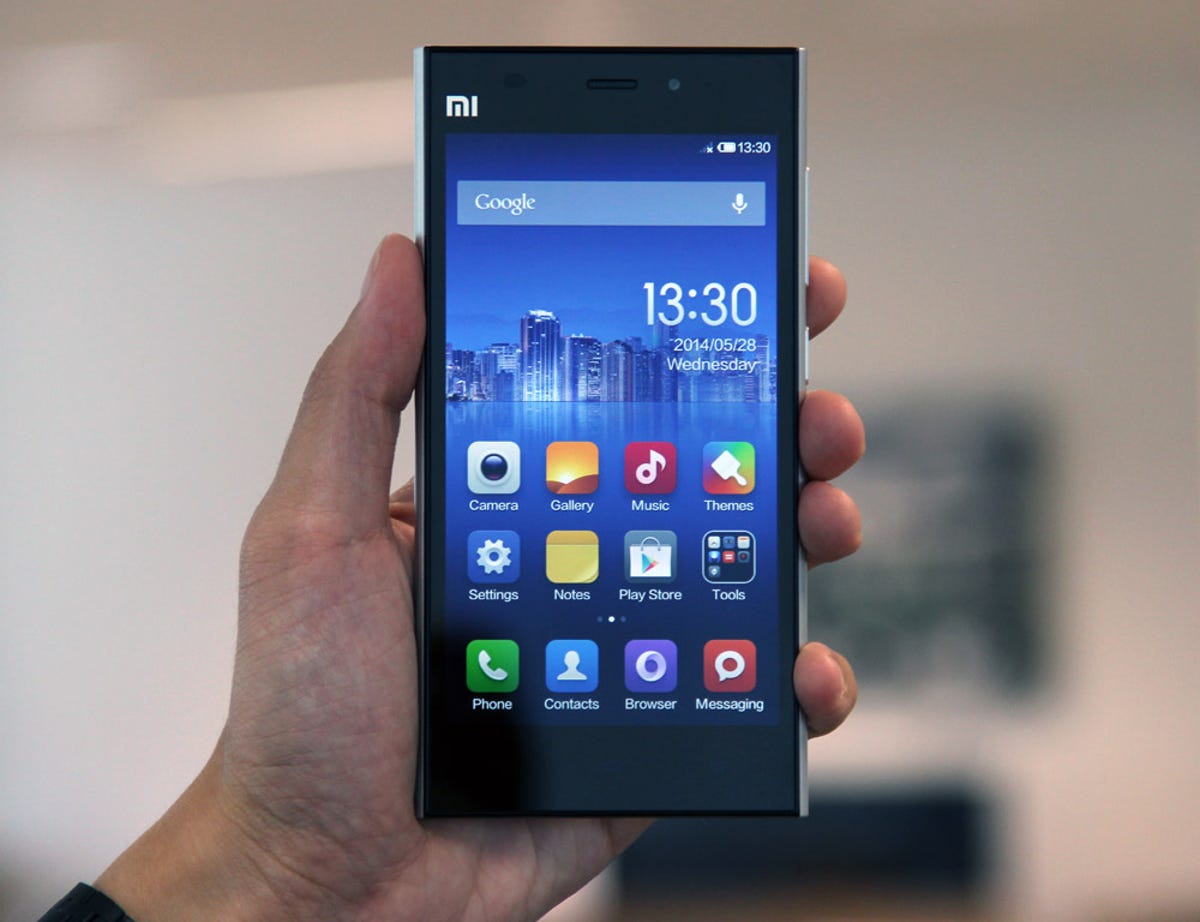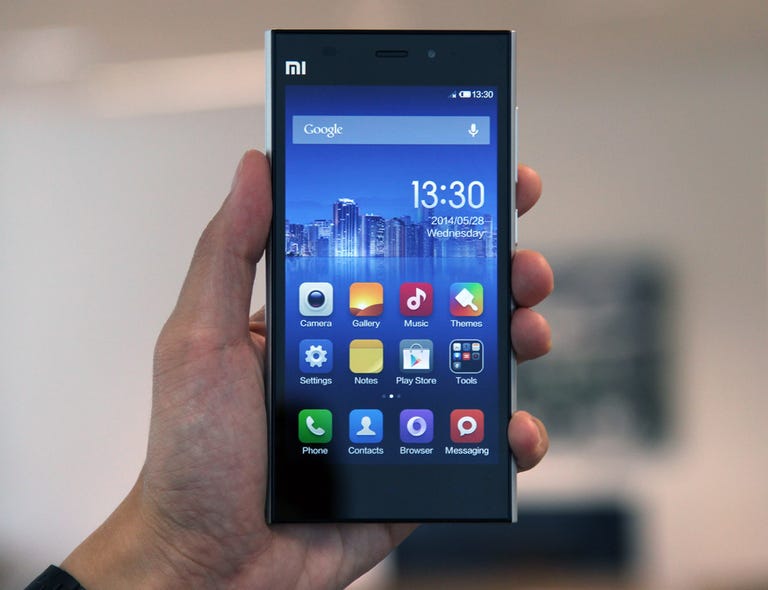 Why You Can Trust CNET
Why You Can Trust CNET Xiaomi Mi 3 review: China's Xiaomi delivers a metallic smartphone for very little cash
Xiaomi's flagship Android phone proves it's possible to get high-quality hardware -- including a full-HD screen and quad-core processor -- for a low, low price.
Xiaomi isn't quite a household name outside of China yet, but that's just for what Hugo Barra, former Googler and now Xiaomi's global VP, is aiming. And if the Xiaomi Mi 3 is any indication of the price and build quality of the company's future phones, Xiaomi's competitors should start paying attention.
The Good
The Bad
The Bottom Line
Announced last year, the Mi 3 is quite the looker -- it comes with an aluminum-magnesium chassis and has a beautiful face with a 5-inch full-HD display covered in Corning Gorilla Glass 3. It's hard to deny the value that this phone represents -- it costs just $270 (£160, AU$290) off-contract -- and once you get your hands on one, you'll be impressed with the build quality and feel.
Currently it's widely available in China, Taiwan, Hong Kong, Malaysia, and Singapore only, but the 3G phone will work globally if you can import one. Online retailers in the UK do stock the phone, but at a premium -- you'll be lucky to find it for less than £220. In the United States, expect to pay at least $375 from online retailers.
Without 4G LTE support, however, the Mi 3 isn't meant to go head-to-head with this year's flagship smartphones from Chinese brands such as OnePlus or Oppo -- instead it is a great alternative if you only need 3G and don't want to renew your contract or pay through the roof for a powerful new phone. Bear in mind, though, the Mi 3 is almost a year old, and a new, refreshed model is likely around the corner.
Design
Since the first Mi Phone released three years ago, Xiaomi has gained a reputation for making good-quality Android devices, and the Mi 3 is no exception. I'm impressed with how great it looks and its build quality. The phone really feels like the 5-inch Android phone Apple would make -- if Apple made 5-inch Android phones.

Compared with other devices from China that tend to have plastic builds, the Xiaomi Mi 3 stands out. It looks like an expensive phone -- and it feels like one. The designers paid attention to the details of the construction, which you can see easily from the machined speaker holes to the seamless joining of the plastic but metallic-looking body and glass front.
There has been much talk of how Xiaomi is trying to copy Apple's approach to industrial design, but the result speaks for itself. I would argue the Mi 3 also rather resembles something from Nokia at its best.
Weighing just 145g (5.2 ounces), you'd expect the phone to be heavier given its plastic body. The Mi 3 is light in your hand, however, and comfortable to grip.
Located at the bottom are the aforementioned speaker holes, as well as a Micro-USB port. On the right side, you'll find the conveniently placed power button, with the volume rockers a little higher up. At the top are the speaker jack and the SIM-card slot. The Mi 3 takes a big, old-fashioned SIM card, since it comes from China (where such cards are still used), so you'll need an adapter if you're switching from a micro- or nano-SIM.
When powered off, the display is a uniform sheet of glass, with the Xiaomi logo at the top left corner. When you do turn on the screen, however, you'll find the touch-sensitive menu buttons in their usual place below the screen. Packing 1,920x1,080 pixels, the Mi 3's screen is capable of handling full-HD video.
Internally, the phone packs a 2.3GHz quad-core Qualcomm Snapdragon 80 processor, 2GB of RAM, and 16GB of onboard storage. The phone has no microSD card slot, and while there's a 64GB version of the phone available, it's not sold outside of China. Connectivity-wise, the smartphone packs all you need to connect to any 3G GSM network around the world, but no 4G LTE. It does have NFC, Bluetooth, and Wi-Fi.
Finally on the rear, you'll find the 13-megapixel camera as well as a dual-LED flash. Xiaomi's attention to detail is also present here: you'll find that instead of making the camera hole a circle like most other smartphones, the company took time to make it square -- just a cool piece of design.
Software and features
One of the biggest draws of Xiaomi's Mi 3 is that it runs the company's own version of Android, called MIUI. You can actually download this and install it on your own phone, but Xiaomi's devices all come running this out of the box. As you can see from my screenshots, it comes with all Google's mobile software, including the Play Store.
I've talked about the MIUI in my earlier review of the budget Redmi , but here's a quick recap on the notable features of the OS.
First up is themes -- MIUI has a powerful theming function capable of changing the look of the UI as well as add custom effects. Its Ferrari theme plays a loud engine roar when you unlock the phone, for example, as well as changing the colors of the UI to a bright metallic red.
MIUI also makes it easy for you to move apps around, you can do a pinch-out action to show the home screens, flick an app downward to collect them, swipe over to a new screen and move all the collected apps there. If you're just moving one app, you can hold on the app with your finger, but instead of dragging it to the edge of the display as you would do in iOS or most versions of Android, you can use another finger to swipe the screen. It's a simple but great tweak I've not seen anywhere else.
Xiaomi has left out the Redmi's Lite Mode, however, which basically supersizes icons and makes the phone more user-friendly for people with visual impairments or who aren't so tech-savvy. The Mi 3, then, isn't a phone you'd buy an elderly relative.
There are also built-in security features such as a blocklist to filter annoying spam numbers, a data monitoring tool that allows you to set which apps are allowed to use mobile data or just Wi-Fi, and a virus scanner from Tencent.
Xiaomi claims to have made Android much better, and given its large feature scope and tweaks, it's easy to agree. If you're really savvy and want to try MIUI out before you buy a Xiaomi phone, the ROM is available for download for plenty of devices, though you'll need to root and unlock your device first.
Camera
The Xiaomi Mi 3 has a 13-megapixel camera, similar in pixel count to those found in other flagship phones. The image quality is good, and the shutter is rather snappy. The phone keeps it simple -- there aren't any special tricks such as Asus' low-light mode, but you do get the standard panorama, HDR, and filters.
Performance
Powered by last year's Snapdragon 800 quad-core processor, the phone is responsive and I never noticed it lagging. The phone's UI is also very stable, and I didn't encounter any crashes during my tests. The Mi 3 hit 21,164 in the Quadrant benchmarks, and scored 897.163 MFLOPs over 0.19 second in the Linpack multi-thread test. That's a little slower than the superb OnePlus One , but not disastrously so.
Call quality
Phone calls were crisp and clear, and I had no issues with the phone. Speaker volume is also adequate, but because it's located at the bottom, you will have to cup your hand to direct the audio towards your ears when watching video.
Battery life
Packing an embedded 3,050mAh battery, the phone easily lasted more more than a day of moderate use. The phone also comes with various different power modes, so you can select the battery saving option to stretch the uptime further.
Conclusion
Xiaomi has crafted a beautiful, classy device in the Mi 3, and while it may be a little dated, the phone is still one of the better ones you can get today. If you need a huge amount of storage for songs and videos, however, 16GB with no microSD slot likely won't be enough for you.
That said, it's hard to deny how much value Xiaomi has packed into this phone. Compare it to the $349/£299/AU$399 Google Nexus 5 , which has the same amount of storage, but a much less pleasing plastic chassis. Against the similarly priced Moto G , the Xiaomi holds up particularly well, with a better processor, camera and screen.
Like many other Chinese-made handsets, the Mi 3 is a top-notch Android phone that easily justifies what you pay for it...and offers a lot more besides.
June 22, 8.45 p.m.: Updated to correct errors about the material used for the phone's body. It's plastic, feels metallic. However, the chassis uses an aluminum-magnesium alloy for rigidity.


